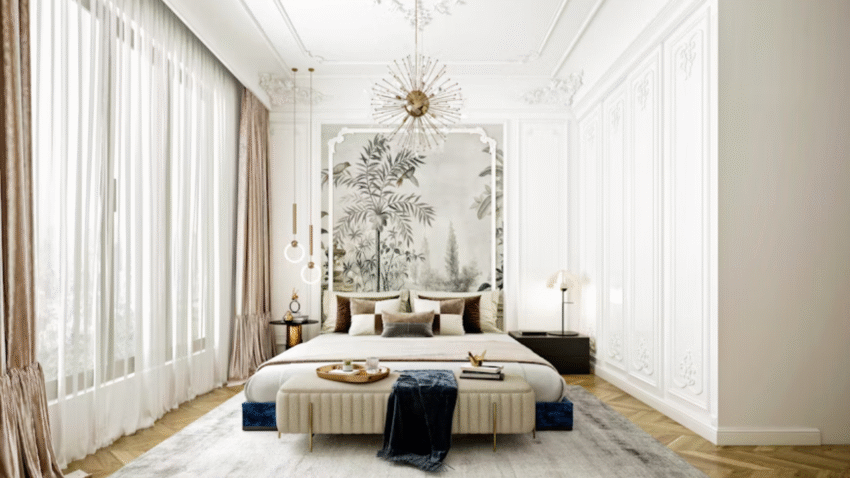Introduction
Does your bedroom feel cramped, no matter how tidy you keep it? Knowing how to make a bedroom feel bigger with furniture placement is one of the smartest ways to open up your space without knocking down a wall. With a few clever layout tricks, you can create better flow, more floor space, and a lighter, airier vibe — turning even the smallest bedroom into a comfortable, spacious retreat.
Why Furniture Placement Matters in the Bedroom
Your bedroom should feel restful, not cluttered. Poor furniture placement can block natural light, create awkward walking paths, and make your room feel boxed in. Smart placement, on the other hand, helps the room breathe, improves function, and highlights your bed — the star of the space. Arranging furniture thoughtfully can make your room look larger than it actually is, keep it organized, and help you sleep and relax better.
Step-by-Step Guide to Make a Bedroom Feel Bigger with Furniture Placement
1. Start with a Clean Slate
Remove as much furniture and décor as possible so you can see your room’s actual shape. Measure your bedroom’s dimensions and make note of doorways, windows, and any awkward corners. This helps you plan a layout that makes the most of your space.
2. Position Your Bed Strategically
Your bed is the focal point — its placement sets the tone for the rest of the room. Whenever possible, place the headboard against the longest solid wall and make sure you can access both sides easily. Centering the bed makes your space feel balanced and airy instead of cramped in one corner.
3. Leave Space Around the Bed
Designers agree: circulation space is key. Leave at least 18–24 inches on each side of the bed and at the foot if possible. This extra walking room keeps the space from feeling boxed in and helps you make the bed easily.
4. Scale Your Bed Size to the Room
A king-size bed in a tiny room swallows up space. If your bedroom is small, consider a full or queen bed instead. Platform beds with low profiles make ceilings feel taller, and beds with open frames (like slatted bases or legs) show more floor, visually expanding the room.
5. Use Multi-Functional Furniture
In a tight bedroom, every piece should work double duty. Choose nightstands with drawers or shelves to store clutter out of sight. Try a storage bench at the foot of the bed for extra linens or shoes. Opt for a bed with built-in drawers underneath to free up closet space.
6. Place Larger Furniture Along the Wall
Keep bulky items like dressers, wardrobes, or desks against walls to maximize open floor area. Floating larger pieces away from walls can create awkward dead space and block traffic flow.
7. Create a Clear Pathway
Make sure you have a direct, unobstructed pathway from the door to the bed. Avoid placing furniture where you’ll bump into it every time you walk in. A clear path instantly makes your room feel larger and more functional.
8. Use Mirrors to Reflect Light and Space
Though not furniture, mirrors are powerful layout tools. Position a mirror across from a window or behind a dresser to reflect natural light and give the illusion of more space. Mirrored wardrobe doors are a great trick for small bedrooms.
9. Keep Furniture Low and Light
Furniture with low profiles — like short dressers or platform beds — leave more visual wall space, making ceilings look higher. Light-colored finishes or glass and acrylic furniture pieces feel less bulky than dark, heavy pieces.
10. Avoid Blocking Windows
Never place tall furniture like wardrobes or bookshelves in front of windows. Natural light is your best friend in a small room — blocking it makes the space feel smaller and darker.
11. Think Vertical
Use vertical space to your advantage. If you need extra storage, opt for tall, slim bookshelves or wall-mounted cabinets instead of wide, deep pieces. This keeps your floor area open while adding functional storage.
Common Mistakes to Avoid
Mistake 1: Pushing all furniture against every wall.
Solution: While this seems logical, it can make the room feel boxy. Leave a few inches between furniture and the wall or float small pieces like a chair to create better flow.
Mistake 2: Keeping furniture you don’t need.
Solution: Too many pieces crowd the space. Edit ruthlessly and keep only what serves a purpose.
Mistake 3: Blocking pathways.
Solution: Always test your layout by walking through it. Make sure drawers and doors open easily and nothing obstructs your movement.
Mistake 4: Using oversized furniture.
Solution: Scale down where possible. Choose pieces that fit your room’s dimensions and serve multiple functions.
Mistake 5: Forgetting about corners.
Solution: Corners are valuable real estate. Tuck in a corner shelf, reading chair, or small desk to make use of dead space without crowding the center of the room.
Extra Tips & Bedroom Hacks
• Try a Floating Nightstand: Wall-mounted bedside tables free up floor space and make the area feel more open.
• Use Clear or Leggy Furniture: Clear acrylic or glass furniture, or pieces with exposed legs, allow light to pass through and help the room feel less crowded.
• Stick to a Light Color Palette: Light walls, bedding, and furniture finishes bounce light around and make a small room feel airy and spacious.
👉 Want even more space-saving tricks? Read our guide on how to use mirrors to make a bedroom feel bigger for the perfect finishing touch.
Conclusion
Now you know exactly how to make a bedroom feel bigger with furniture placement — from smart bed positioning and clear pathways to choosing the right scaled-down, multifunctional pieces. A few intentional moves can open up your bedroom, making it feel calm, organized, and twice its actual size.
✨ Bookmark this guide to transform your bedroom into a spacious, comfortable haven you’ll love coming home to every day!
